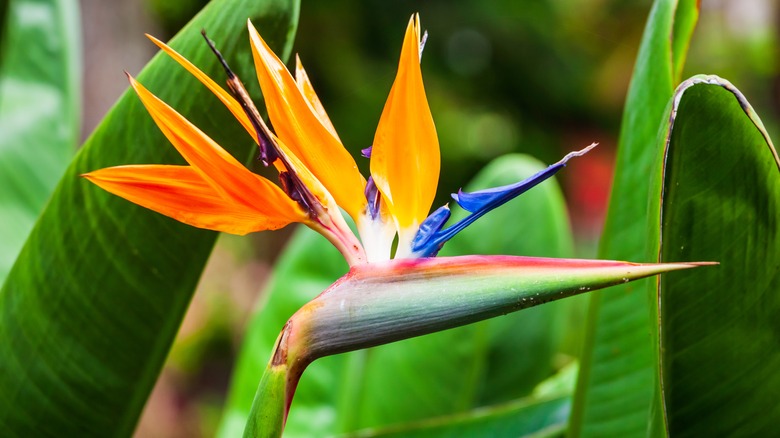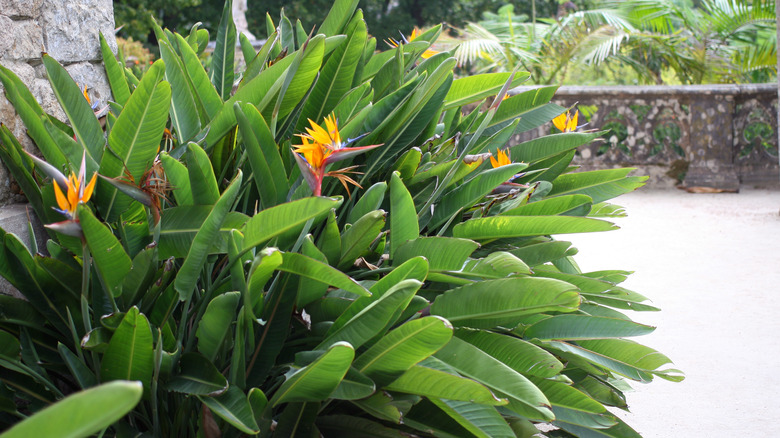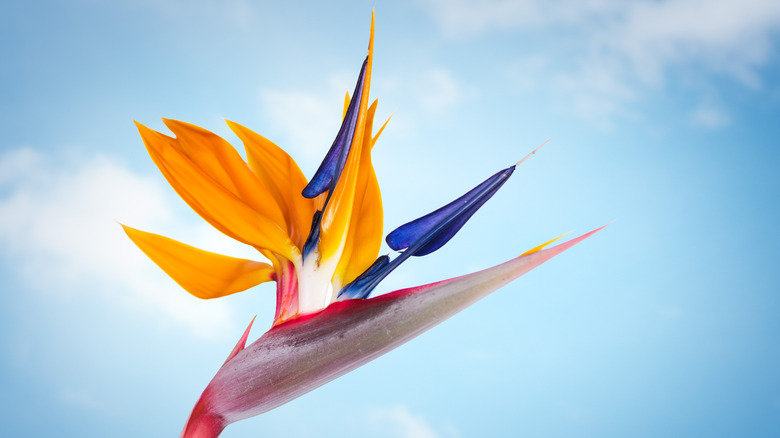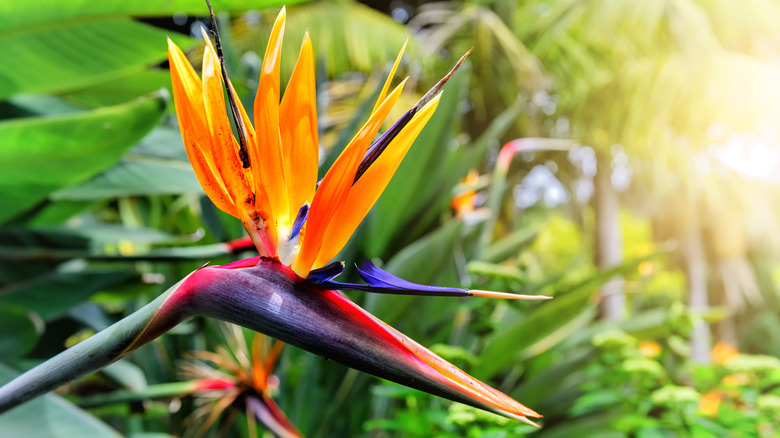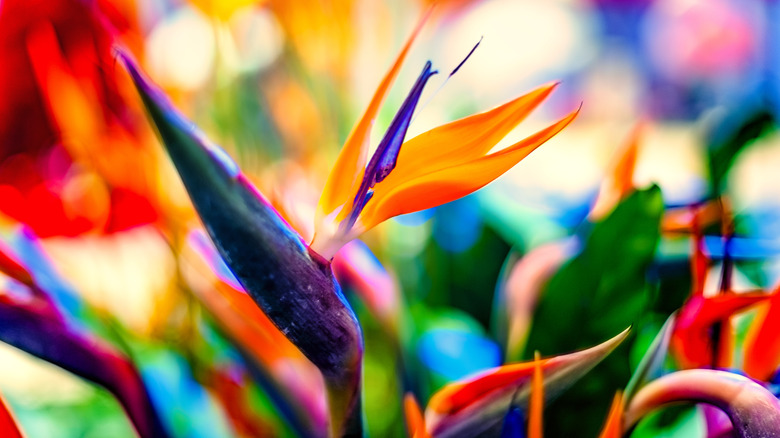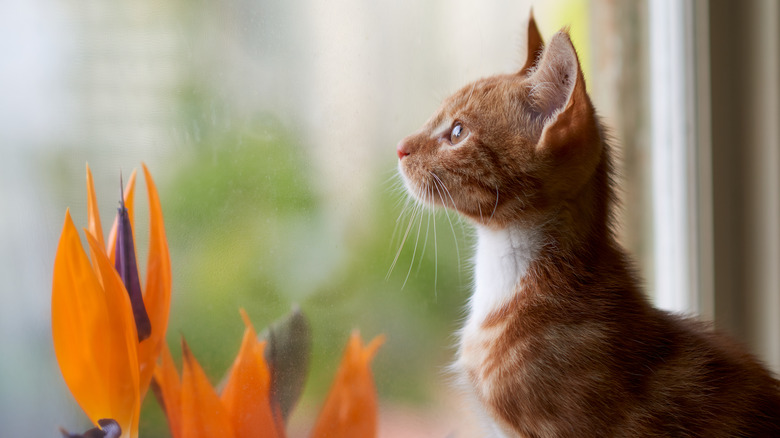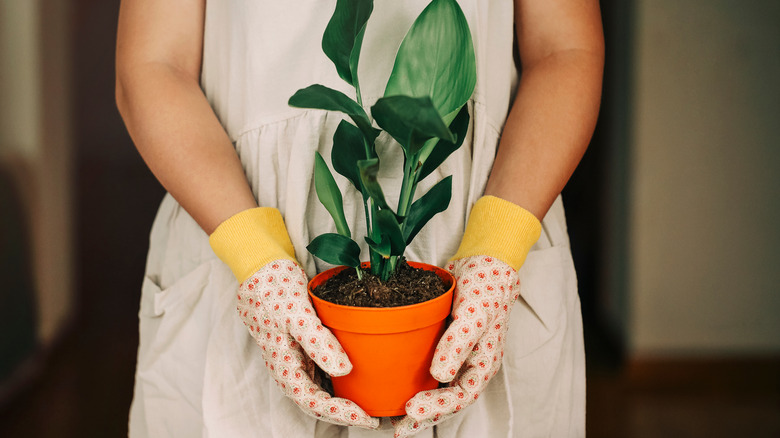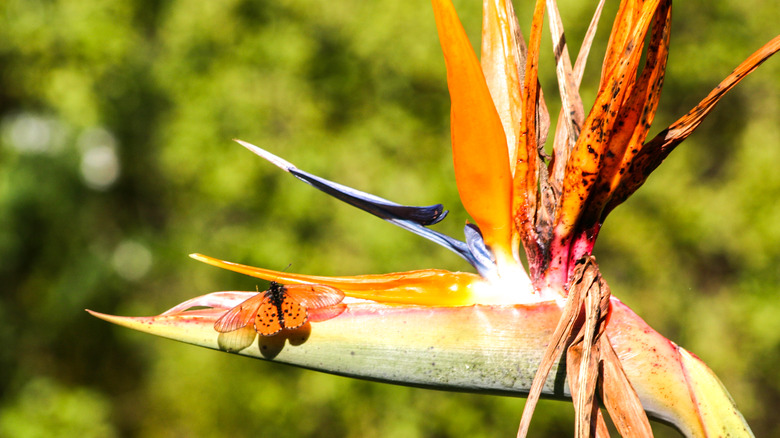Bird Of Paradise: Everything You Should Know Before Planting
Bird of paradise, also known as the crane flower (scientific name: Strelitzia) is one of the most recognizable members of the plant kingdom due to its unique blooms that resemble birds in flight. The blooms consist of a thick, pointed sheath that grows at a 90-degree angle to the stem. From the top of this sheath sprouts a handful of colorful flowers, ranging in color from orange to yellow, blue, and purple. The sheath itself is often streaked in color as well. The rest of the plant is made up of thick, verdant-green leaves that can grow up to 28 inches in height, as per SFGate. The entire plant reaches heights of between 3 to 30 feet, making it a focal point of any garden.
This stunning tropical plant has royal origins, dating back to the 18th century. Sir Joseph Banks, director of the Royal Botanic Gardens in Kew, South Africa, coined the scientific name for bird of paradise in honor of Queen Charlotte, also known as the Duchess of Mecklenburg-Strelitz, according to FTD by Design. Bird of paradise has come to symbolize much more than royalty — depending on the country in which it grows, it can symbolize anything from joy to faithfulness and even a positive outlook on life. This plant is easy to grow both indoors and outdoors as long as it is given the proper growing conditions. Keep reading for a guide on how to grow and care for your bird of paradise.
How to use bird of paradise in garden
There are many ways you can design your garden to make bird of paradise a focal point that anyone who visits will love. This plant is a great option for creating layers in your garden, as per SFGate. As a fairly large plant, it should be planted along walls or other borders in your yard. You can then add other smaller flowering plants in front of your birds of paradise to contrast with the numerous green leaves and ensure your garden is bursting with color. Another way to design your garden around bird of paradise is through taking advantage of this plant's many colors. By choosing neighboring plants that feature similar colors, you can create a bold landscape that will draw attention to the bird of paradise blooms.
Keep in mind that bird of paradise is a tropical plant, meaning it can only be grown outdoors in warm climates. However, if your climate experiences hot summers and cold winters, you don't have to forgo the beauty this plant will add to your outdoor space — simply plant it in a container to keep indoors during the winter and take outdoors during the summer. If you opt for container planting, your options are many for designing your garden. Not only can this plant become a beautiful addition to a patio or deck, you can also easily move it around in accordance with the bloom times of other flowers in your yard.
How to grow bird of paradise
It is possible to grow bird of paradise by seed, but this method takes much longer to see results as this plant is incredibly slow growing. To immediately enjoy your bird of paradise plant, consider propagation by division. Fortunately, this method is quite easy to carry out yourself. When spring comes around, you should dig into the ground or container to expose the roots of the plant, as per Gardening Know How. You'll then cut a piece of rhizome to divide the plant. When you make the cut, take care to include a fan (also known as a stem) with roots attached to ensure your bird of paradise will thrive when re-planted. Finally, give the part of the plant where you made the cut an application of rooting hormone to increase the chances of successful growth.
If you are planting your propagated bird of paradise in the ground, dig a hole to a depth matching the length of the roots you cut from the parent plant — it is best for birds of paradise to be planted close to the surface as their roots will extend deep into the soil as they grow. Fill in the hole with soil. For container planting, Gardener's Path suggests a pot measuring 8 to 12 inches deep for adequate room to grow. Keep in mind, however, that larger cuttings will need larger containers. During the first three months, take care to keep your bird of paradise well-watered.
How to care for bird of paradise
Birds of paradise are fairly easy to keep happy as long as they are provided with the ideal growing conditions that allow them to thrive. Whether grown indoors or outdoors, one of the most important needs this plant has is for adequate sunlight, as per The Spruce. The light they receive needs to be intense, but not necessarily direct the whole day. A few hours of direct sunlight should be enough as long as these hours take place in the morning or later afternoon. Direct sunlight during the time of the day when the sun is at its strongest can cause leaf burns.
The next condition you'll need to meet is watering. Birds of paradise need to be watered regularly all year round to keep their leaves and blooms healthy. You should never let the soil dry out between waterings, but should take care to ensure the soil is never soggy as this can contribute to rot and other problems. A good rule of thumb is to water daily during the hottest months of the year and water as needed during colder months. To avoid overwatered soil, make sure the container has adequate drainage holes. If it doesn't, you can always drill more yourself. Going hand in hand with water is humidity. As a tropical plant, bird of paradise should be misted throughout the year and should never be forced to tolerate excessively dry or cold conditions.
Varieties of bird of paradise
Birds of paradise (scientific name: Strelitzia) consist of just five species, all hailing from southern Africa, as per Gardener's Path. They all feature the signature bird-like bloom, but vary in color scheme and size. The leaf size and shape also differ from species to species. Strelitzia reginae is the most popular of the group, notable for its bright blooms, which often feature neon-orange petals. It is also one of the smaller varieties, making it the perfect houseplant as it only grows between 5 and 6 feet in height. Strelitzia nicolai is larger than S. reginae, hitting heights of 20 feet when fully mature. Its colors aren't as striking, however. The bloom sheath can be lavender or black in hue while the petals are often white, purple, or blue.
Strelitzia caudata is the third of the five species of bird of paradise. Like its cousin S. nicolai, S. caudata is a sight to behold with a fully grown height of 20 feet. The sheaths of this variety are black in color while the petals are white, providing a striking contrast. If you live in a tropical climate, this makes a great outdoor variety. Fourth on the list is Strelitzia alba, which is more comparable to a tree than a plant due to its height of around 30 feet. Blooms are dark purple with white petals. Finally, we have Strelitzia juncea, which is marked by thinner leaves and bloom hues similar to those of S. reginae.
Is bird of paradise toxic?
Bird of paradise is not considered a toxic plant to humans, as per National Capital Poison Center. However, if accidentally ingested, this plant has the potential to cause gastrointestinal distress, though this is rare. If someone in your family, especially a small child, has ingested a part of this plant and is showing symptoms of toxicity, such as an upset stomach, vomiting, or diarrhea, you should always contact your local emergency medical center for assistance.
While not considered a toxic plant to humans, bird of paradise is toxic to animals. The bloom is the most toxic part of the plant as the seeds contain chemicals that aggravate the digestive system, according to Pet Care Advisors. Common symptoms of poisoning include vomiting and lethargy. As with humans, you should contact your local veterinary center in the case of accidental ingestion.
If you have pets and are worried about them eating your birds of paradise, there are preventative measures you can take to ensure the safety of all members of your household. Repellant sprays are a popular way to deter animals from chewing on plants as they are bitter in taste. While not always the most practical option, you can also keep your birds of paradise in a separate, off-limits part of your house with a door or barrier that your pets cannot cross. Similarly, in the garden, you can put up a fence around your birds of paradise to accomplish the same goal.
How to repot bird of paradise
The bird of paradise plant will need to be repotted annually until it reaches full maturity, as per The Spruce. This ensures that the plant reaches its full size and, as a result, is able to produce blooms. If you already have a mature bird of paradise plant, you won't need to do anything except keep the top layer of soil fresh and provide the plant with fertilizer during the growing season. If your plant is still growing, you'll want to purchase a new container in the next largest size every spring and repot it.
For the best growing conditions, always buy a container with adequate drainage holes or create them yourself at home with a drill before replanting your bird of paradise. You will also need to buy a well-draining soil designed for potted houseplants. To repot your plant, first spread a layer of soil along the base of the container. Next, gently remove your bird of paradise from its old container and shake the soil off the roots. Throughout this process, take care not to damage the roots of your plant so as not to impair its ability to grow. Once placed in its new home, fill in the empty spaces with potting mix up to the top of the container. The last step is to water generously. After repotting, stick to the same watering schedule as outlined above.
Bird of paradise pests and diseases
While not prone to attacks from pests and diseases, birds of paradise are susceptible to a few that threaten its survival. Mealy bugs and scale are two pests that feed on the plant and can cause wide-scale destruction in large quantities, as per SFGate. Mealy bugs present as white spots on the leaves while scale presents as brown spots. In either case, you'll need to spray an insecticide to get rid of the infestation and ensure they don't come back. Neem oil is another popular way to treat insect infestations. You should also dispose of severely infected plants to avoid continued spread.
Root rot and leaf blight are two diseases caused by fungi that can eventually kill your birds of paradise if left untreated. The first is generally caused by excessive moisture in the soil that allows fungal spores to thrive, which in turn slowly kills your plant from the base up. The best way to prevent root rot is through close monitoring of the plant's water needs and taking care not to overwater. Once affected by the disease, however, you will need to treat it with a fungicide and let the soil dry out. In extreme cases, you may need to repot your plant entirely with fresh, dry soil. Leaf blight is another fungus-based disease that attacks the leaves of the plant. Again, a fungicide is the best course of treatment in the case of a leaf blight attack.
